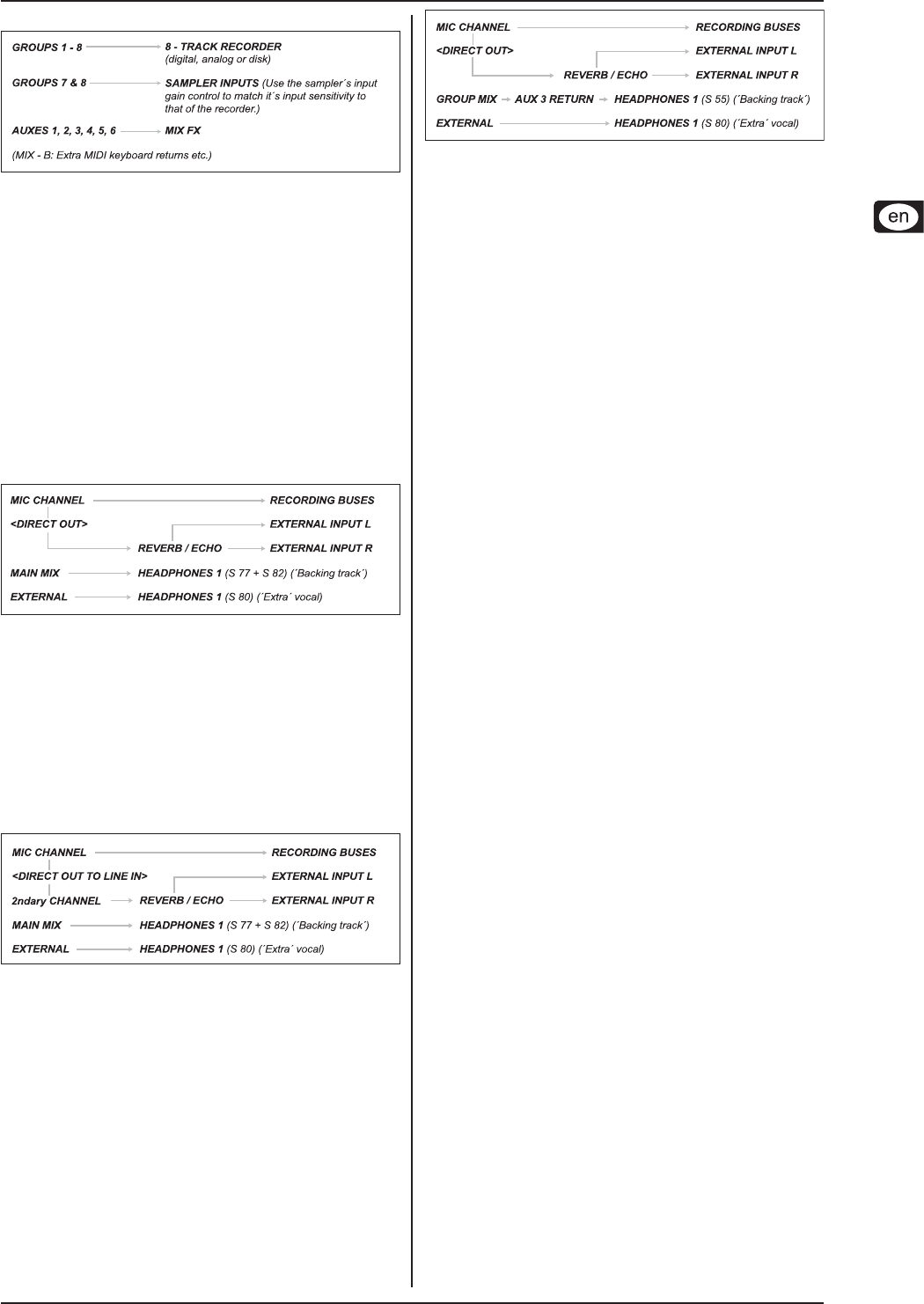
EURODESK SX4882
8-track MIDI suite/dance production studio 19
Sends14.1
Send routingFig. 14.1:
In a dance production, effects are often of paramount importance
in creating interesting/evolving sounds, and aux sends are usually
all dedicated to this purpose. Also, it is not unusual for a vocalist
to be drafted in to add some colour to the mix at a late stage. The
following set-ups avoid using aux sends for headphone monitoring,
while enabling both the vocalist and engineer to get a comfortable
headphone mix.
Auxless headphones mix14.2
The vocalist will probably want to hear her-/himself above the
normal mix level. With the following headphone sources you can
do this without tying up any aux sends or MIX-B. Passing the
DIRECT OUT through any 1 in 2 out delay/reverb device enables
the vocalist to choose an effect she/he is comfortable singing
along with.
Simple auxless headphones mixFig. 14.2:
Here the MIC CHANNEL FADER controls the amount of extra voice
blended into the main mix. Adjust the FADER level rst until the
vocalist is happy, then set the level to tape with the SUBGROUP
FADER(S).
Alternatively:
Split the microphone onto two channels and use one to feed the
routing matrix while the other drives the EXTERNAL input via its
direct out. Now you have totally indepedent monitoring and tape
send levels for the vocal signal.
Slightly more complicated auxless headphones mixFig. 14.3:
Alternatively:
If you need to hear the harmonies, but they’re putting the vocalist
off key, you’ll want to be able to delete channels from the head-
phone mix. If you still don’t want to assign a couple of aux buses
to headphones monitoring because this would disturb the main
mix, the following suggestion might prove useful. Set up a separate
channel assignment on a spare subgroup pair. Feed the output
into aux return 3. Route aux return 3 to headphones 1 (S 55) and
de-assign the main mix (S77). Now you can delete distracting
channels from the vocalist’s backing track mix (see g. 14.4).
Subgroup-driven auxless headphones mixFig. 14.4:
This conguration does not allow for anything coming in on
B-channels to be sent to headphones. If you need to do this, S76
must also be depressed.
In all cases the WET/DRY balance of the extra vocal +
signal takes place within the FX processor.
The above example refers to aux 3 return > headphones +
1. An analogous situation is possible for aux 4/5/6 return
> headphones 1 or 2.
Returns14.3
Channels 1 to 8: When you’ve only got eight tape returns, you
can afford to bring them back on main channels to enable e.g.
chorus vocal comps. or recorded real-time mixing effects such
as frequency sweeping to be quickly bounced or sampled off via
subgroups.
Channels 9 to 23: The most important SYNTH/SAMPLER outputs.
Those most likely to need full EQ or to be recorded to tape. You
might have one Minimoog, but half-a-dozen uses for it. Put it on
an A-channel. You’ll want to record and/or sample it in action.
Channel 24 is of course the MIC input. A compressor might be
patched into the channel 24 insert. Keep this channel free until the
mix absolutely demands its services, just in case you want to add
in any last minute singing, or any last minute anything!
The B-channel line inputs (tape returns) can accomodate even
more MIDI expanders and synths, etc.
Lining up record/sample inputs14.4
Set the relevant TAPE OUTPUT and INPUT switches (located
at the rear of the console) to match the operating level of your
8-track (consult manual, “phone manufacturer”, or simply “suck
& see” to nd which setting works best). The sampler’s variable
input gain range should be more than wide enough to accept ei-
ther -10 dBV or +4 dBu. There is no oscillator in the EURODESK
SX4882, but you can use a simple unmodulated sustained tone
from a keyboard. Choose one around 1 kHz (B above middle C
is 997 or 1002 Hz depending on whether you are using the tem-
pered scale or “just” tuning: either way it’s close enough for jazz).
Set the channel EQ to OFF, and line up the channel according to
the “Setting up procedure” (section 13.1). Route this signal to all
subgroups and adjust the SUBGROUP OUTPUT FADERS until
the bargraph meters read 0 dB. Now put the recorder into INPUT
mode on all channels, and the sampler into SAMPLE mode. If
the tape operating level switches are correctly set, then 0 dB on
the subgroup output meters should also show 0 dB on the tape
recorder’s input meters. A discrepancy of +/-14 dB indicates a
wrong operating level selection. Small discrepancies may be taken
up by the SUBGROUP FADERs, though a better solution would be
to get the multitrack, properly aligned. (Refer to multitrack manual
and/or qualied personnel.) Adjust the sampler’s input level until
it also reads 0 dB.
Beware of inaccurate/uncalibrated sampler input meters. +
Work out how hard you can safely drive the sampler’s
input, reference this to 0 dB on a EURODESK subgroup
meter, then take note of the sampler’s input gain pot
setting. (Or use soft adhesive tape etc. to hold it in one
position.)
(For more info on digital metering and associated problems see
section 13.2.3.)


















